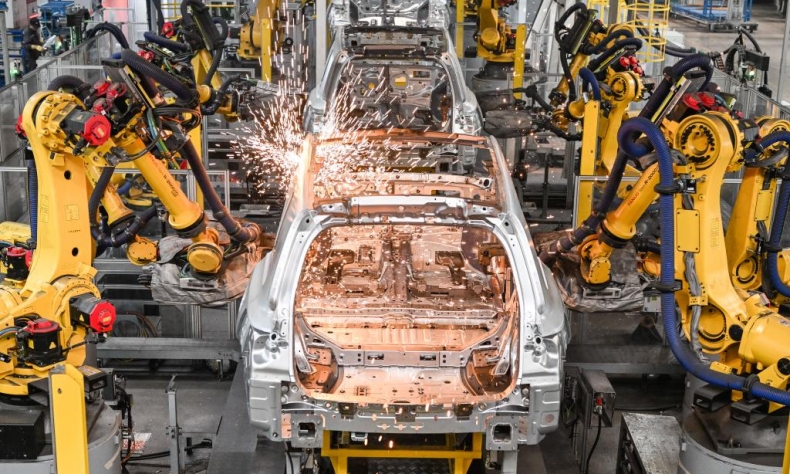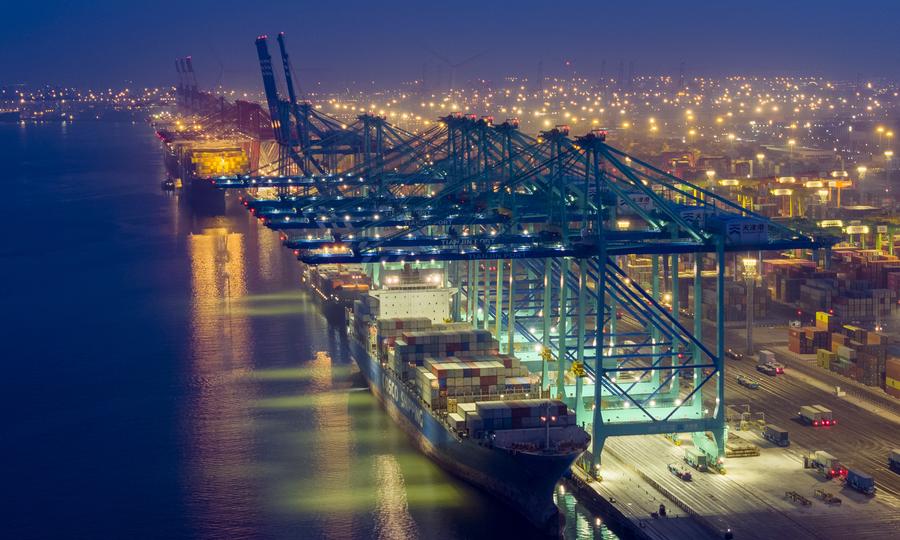Chinese Economy Scales New Heights

China’s favorable position in the new round of technological and industrial competition provides sufficient confidence and support to the ‘bright theory of China’s economy.’
China’s government work report delivered to the 2024 “Two Sessions” in early March released some important statistics.The GDP surpassed RMB 126 trillion, an increase of 5.2 percent. A total of 12.44 million urban jobs were added, and the average surveyed urban unemployment rate stood at 5.2 percent by average. The consumer price index (CPI) rose by 0.2 percent. The production and sales of new-energy vehicles accounted for over 60 percent of the world’s total. Grain output hit a record high of 695 million tonnes. The installed renewable energy capacity surpassed its thermal power for the first time in Chinese history, accounting for over half of newly installed renewable energy capacity worldwide. The per capita disposable income of residents also rose by 6.1 percent nationwide.
These positive figures confirm the strength, resilience, and prospects of the Chinese economy, which has withstood the scarring effects of the Covid-19 pandemic, the impact of a volatile international situation, and interruptions by extreme weather events over the past year.
Undaunted and determined
It was no easy task to register these achievements. Last year the global economy, though not in a crisis, was sluggish. Due to interest rate hikes in much of the world, led by the U.S. Federal Reserve, China’s foreign trade had to cope with dwindling demands and weaker growth following a strong performance in the previous three years. On the geopolitical front, the Russia-Ukraine conflict deepened, and the Israel-Palestine crisis escalated. Geopolitical rivalry over these hotspot issues accelerated the fragmentation and blocization of the global economic system. Meanwhile, under the banner of “outcompeting China,” the U.S. kept erecting protectionist “walls” in a growing number of industries in an effort to keep China out of the global supply chains.
Within China, the recovery in domestic consumption was slower than expected. The adjusting real estate sector triggered mounting concerns about local government debts and risk exposures for small and medium-sized financial institutions. A cacophony of talking down China has hence increased in volume. This was evidenced by certain foreign media outlets and research institutes spreading distorted views about China, such as its economy has peaked, its stimulative policies did not work, and its business environment has deteriorated. They echoed the American and European policies of “de-risking,” combatting the “economic threat from China,” and pursuing “collective economic security.” Their goal is to discourage foreign investment from flowing into China, diminish global confidence in the Chinese economy, and eventually suppress the country’s development momentum.
China is fully aware of the risks and challenges it faces. The Chinese government acknowledged in its latest work report, “Looking back at 2023, we can see that as we faced an array of interwoven difficulties and challenges, China’s economy grew in a wave-like fashion amid twists and turns.”
Last year China focused on six tasks: strengthening macro regulation and promoting steady economic recovery and growth; promoting industrial upgrading through innovation and gaining new momentum for coordinated urban-rural and regional development; deepening reform, expanding opening-up, and continuing to improve the business environment; stepping up efforts to protect and improve the environment and accelerating the transition to a model of green development; ensuring public wellbeing and advancing the development of social programs; improving government performance across the board and redoubling efforts to enhance governance. These measures allowed China to achieve its goals of economic and social development for the year. Contributing to one-third of the global economic growth, China has fulfilled its responsibility as the world’s second largest economy and continued to be a key driver of international growth.

Figures are important indicators of economic performance. It is however more important to understand the changes of the fundamentals of the economy and the thinking behind its development. The pessimistic views of the Chinese economy are either based on a simplistic comparison between its earlier and recent growth rates, or a discriminative analysis of certain data. Both amplify the short-term fluctuations and temporary difficulties in the Chinese economy, and lead to a foregone conclusion. They are in fact no more than a retrofit of the “China collapse” theory that have been debunked repeatedly in past decades.
Several factors can be attributed to these biases. First, the Washington Consensus has become a thing of the past, but some Western countries still attempt to impose it on China. Since the introduction of the reform and opening-up policy more than 40 years ago, the Chinese economy has grown exponentially in size and strength. With the world’s largest middle-income group and most complete industrial system, China has proven that its path to modernization is successful. Western theorists, however, are still struggling to accept or understand this reality.
Second, the U.S. holds a myopic view on how an economy operates. Washington chose drastic increases in money supply and fiscal stimulation tools to bring its economy back on track after the pandemic. In contrast, China has adopted more restrained policies for macro regulation, paying equal attention to pursuing steady recovery and building growth momentum. Instead of adopting a deluge of strong stimulus policies for instant effects, it puts more efforts into promoting high-quality development over the long term. This approach reflects China’s strong sense of responsibility toward its people’s wellbeing and global economic stability. The Western beggar-thy-neighbor monetary policy has plunged the world into a quagmire of high inflation. If China follows this example, more developing countries would have been swallowed by the economic and social crises caused by soaring prices.
Third, certain people are continuing to wage a smear campaign against China. The U.S.- China competition game has heightened the “value conflict” view and “national security concerns,” driving the trend of seeing the mode and practices of economic development as ideological issues. When China improves its laws, it is accused of deteriorating the business environment; when it issues guidance for an industry, it is blamed for going after private businesses. There continues to be inherent political correctness in all forecasts for dim prospects of the Chinese economy.
New quality productive forces lead high-quality development
According to the expected goals set in the government work report, China’s economic express will continue to maintain medium-to-high speed in 2024, traveling along the road of high-quality development. In 2024, China is expected to achieve a growth rate of about five percent and create more than 12 million new urban jobs, which is admittedly a “pretty bold” target, even in the eyes of many foreign media, who normally have a harsh attitude toward China. At the same time, China’s fiscal deficit rate remains at three percent, and its monetary policy remains stable, which highlights the stability and confidence of the new term of government in China’s set path for economic development. China has not changed the established policies due to interference from outside, but remains firm in promoting stable and long-term economic development. We have seen China’s optimization and innovation of its economic tools, such as the emergence of ultra-long-term special treasury bonds, and the government’s response to the demands of market entities, emphasizing more consistency in macro policy orientation and creating a transparent, stable and predictable policy environment. We have also seen the comprehensive deployment of the 10 major tasks in 2024, focusing on making precise efforts to resolve the main contradictions in China’s economy and society.

The biggest highlight is undoubtedly the first mention of the term “new quality productive forces” in the government work report. New quality productive forces is productivity based on technological innovation. It is China’s precise grasp and positive response to the new wave of technological revolution and industrial transformation that is emerging around the world. The rapid development of the artificial intelligence revolution symbolized by ChatGPT, and the acceleration of the global carbon neutrality trend are profoundly and rapidly reshaping the global industrial model and governance structure, bringing an opportunity to reshuffle the global economic landscape. In the competition among countries, if a country can seize the development opportunities brought by emerging industries, it will undoubtably usher in a bright future.
“Striving to modernize the industrial system and developing new quality productive forces at a faster pace,” and “invigorating China through science and education and consolidating the foundations for high-quality development” are listed as the first and second points of the major tasks for 2024 in the government work report, breaking the previous years’ practice of prioritizing measures to stabilize the economy and promote growth, which fully demonstrates that China attaches great importance to scientific, technological and industrial innovation.
In practice, the vigorous development of emerging industries is profoundly changing the background of China’s economic growth, driving China’s economy to embark on a high-quality development path that is smarter, more environmentally friendly, and more efficient with a high input-output ratio. The “new trio” represented by new energy vehicles, lithium batteries, and photovoltaic products are becoming new growth poles and stabilizers of China’s exports. Chip manufacturing is catching up, and the number of artificial intelligence patent applications ranks first in the world. Hydrogen energy, biopharmaceuticals, the commercial aerospace manufacturing industry, and a low-altitude economy are on the eve of an explosion, with a number of competitive companies mushrooming.
Objectively speaking, the blockade and suppression of China’s science and technology fields and emerging industries by the United States, Europe and other countries will cause certain problems for China, but to some extent it is also an “endorsement” for China’s science and technology and industrial competitiveness. The U.S. Information Technology and Innovation Foundation (ITIF) claimed at the end of 2023 that China’s efforts and investments in advanced technology in recent years are paying off, and it has occupied a global leading position in most strategic industries such as computers and electronic products, chemicals, and motor vehicles. China’s favorable position in the new round of technological and industrial competition provides sufficient confidence and support to the “bright theory of China’s economy.”
Continuing the opening policy
China’s door will remain open, and will only open wider. China’s economic miracle is not only the result of the struggle of the Chinese people. The introduction of external ideas, capital, and technology also played their important roles.

Over the past four decades, China and foreign investors have achieved a win-win situation in the globalization process. China has become a favored place for foreign investment, benefiting from the last round of the transference of the global supply chain to become the manufacturer of the world. Foreign investors entering China netted massive returns and excessive benefits for the countries of origin through sharing the dividends of China’s development. As an important part of China’s market entities, foreign investment is a significant factor contributing to China’s economic growth. However, it is undeniable that the pretexts of “supply chain resilience” and “national security” have been cited by the West in its efforts to reverse restructuring of the global supply chain. Coupled with the intensifying competition brought about by China’s industrial upgrading, there has been some degree of reduction and withdrawal of foreign capital from China due to political or economic considerations. As a result, the actual utilization of foreign capital in 2023, though still remains in the historical high range, was lower than before.
Responding to this new situation, the Chinese government has taken some active measures. In August 2023, the State Council issued a guideline to further optimize the foreign investment environment and intensify efforts, including 24 specific measures in six aspects to attract foreign investments. At the Third Belt and Road Forum for International Cooperation in October 2023, President Xi Jinping announced that China would remove all restrictions on foreign investment access in the manufacturing sector, and further advance high-standard opening-up in cross-border service trade and investment in light of international high-standard economic and trade rules. The government work report delivered to this year’s “Two Sessions” declared to further shorten the negative list for foreign investment, expand the Catalogue of Encouraged Industries for Foreign Investment, strengthen services for foreign investors, and resolve key issues, such as cross-border data flow, which are of great concern to foreign investors.
As Foreign Minister Wang Yi stated at the “Two Sessions,” China’s development is inseparable from the world, and the world also needs China to prosper. Spreading pessimistic views on China will only cause harm to the propagators, and misjudging China’s prospects will result in missed opportunities. In today’s world, where the international situation is becoming increasingly turbulent and uncertain, China — with its peaceful and stable political and social environment, a super-large-scale single market with a population of more than 1.4 billion, a huge demographic dividend and a pool of high-quality talents and a high-level and institutionalized open environment — can undoubtedly provide greater certainty for risk-averse foreign investment. These aforementioned factors make China the best investment destination and a safe haven for foreign enterprises pursuing economic efficiency and cost advantages. The rate of return on foreign direct investment in China in recent years has been around nine percent, which is still at a high level in the international arena. In the future, China’s economy, which is moving toward a high-quality development path with vigorous development of new quality productive forces, will surely bring more development opportunities and investment returns for foreign investment.
“The Chinese economy is a sea, not a pond. Storms can overturn a pond, but never a sea,” is a famous remark made by President Xi at the opening ceremony of the First China International Import Expo (CIIE) in Shanghai in 2018. These thought-provoking words are a compelling response to those doubting China’s economic prospects.
Xu Gang is assistant director of the Institute of World Economic Studies, China Institutes of Contemporary International Relations.
 Facebook
Facebook
 Twitter
Twitter
 Linkedin
Linkedin
 Google +
Google +










